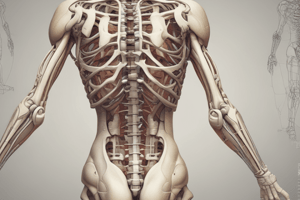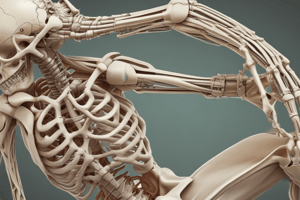Podcast
Questions and Answers
Match the following types of synovial joints with their corresponding joints:
Match the following types of synovial joints with their corresponding joints:
Hinge = Interphalangeal joints (phalanges of hand) Plane = Vertebrocostal joints Pivot = Radioulnar joints Condyloid = Metacarpophalangeal joints (b/t metacarpals and phalanges of hand) Saddle = Carpo-metacarpal joint (b/t trapezium and thumb) Ball and socket = Hip joint
Which joint type is represented by the knee?
Which joint type is represented by the knee?
- Condyloid
- Ball and socket
- Pivot
- Hinge (correct)
Which joint type allows for rotational movement between vertebrae?
Which joint type allows for rotational movement between vertebrae?
- Plane
- Hinge
- Saddle
- Pivot (correct)
What type of joint is the shoulder joint?
What type of joint is the shoulder joint?
Which type of synovial joint is the carpo-metacarpal joint of the thumb?
Which type of synovial joint is the carpo-metacarpal joint of the thumb?
Flashcards
Synovial Joints
Synovial Joints
Joints that allow movement between two or more bones.
Hinge Joints
Hinge Joints
Joints enabling flexion and extension movements.
Pivot Joints
Pivot Joints
Joints that permit rotational movement around a single axis.
Condyloid Joints
Condyloid Joints
Signup and view all the flashcards
Ball and Socket Joints
Ball and Socket Joints
Signup and view all the flashcards
Study Notes
Synovial Joints Overview
- Synovial joints are characterized by their ability to allow movement between two or more bones.
- Various types exist, each with distinct structural attributes and functional roles.
Hinge Joints
- Enable flexion and extension movements.
- Examples include:
- Knee: Largest hinge joint, crucial for walking, running, and jumping.
- Elbow: Allows arm movement, predominantly bending and straightening.
- Ankle: Facilitates foot movement, contributing to walking stability.
- Interphalangeal Joints: Present in fingers, allowing for gripping and dexterity.
Plane Joints
- Allow limited sliding or gliding movements.
- Notable examples:
- Intercarpal Joint: Located between the eight carpal bones of the wrist, contributing to wrist flexibility.
- Intertarsal Joint: Found between the eight tarsal bones in the foot, aiding in foot stability and movement.
- Sternocostal Joints: Joint formation between the sternum and ribs, crucial for ribcage flexibility during breathing.
- Vertebrocostal Joints: Connect vertebrae to ribs, integral for upper body movement.
Pivot Joints
- Permit rotational movement around a single axis.
- Key examples include:
- Atlanto-Axial Joint: Located between the first two cervical vertebrae, enabling head rotation.
- Radioulnar Joints: Allow for pronation and supination of the forearm, critical for wrist movement.
Condyloid Joints
- Enable movement in two planes: flexion/extension and abduction/adduction.
- Important examples:
- Radio-Carpal Joint: Located in the wrist, facilitating a range of hand movements.
- Metacarpophalangeal Joints: Connect metacarpals to phalanges, allowing for finger movement and gripping.
Saddle Joints
- Allow movement in two planes but with greater freedom of movement than condyloid joints.
- Carpo-Metacarpal Joint: Located between the trapezium bone and thumb, crucial for opposable thumb function.
Ball and Socket Joints
- Enable the most extensive range of movement in multiple directions.
- Examples include:
- Shoulder Joint: Allows for a wide range of arm movements and flexibility.
- Hip Joint: Supports weight-bearing and various movements, including walking and running.
Studying That Suits You
Use AI to generate personalized quizzes and flashcards to suit your learning preferences.





